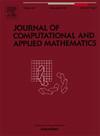应用深度神经网络计算分析分数阶积分-微分方程耦合系统
IF 2.6
2区 数学
Q1 MATHEMATICS, APPLIED
Journal of Computational and Applied Mathematics
Pub Date : 2025-07-21
DOI:10.1016/j.cam.2025.116912
引用次数: 0
摘要
近年来,基于人工智能(AI)的深度神经网络(dnn)受到了研究人员的广泛关注。上述工具为许多实际应用程序提供了最佳解决方案。另一方面,将上述工具与传统和分数阶微积分工具相结合,可以为综合分析现实世界现象和工程学科的许多问题产生重要的结果。微分方程系统在模拟各种实际问题中起着重要的作用,这些问题涉及到常阶或分数阶导数。考虑到上述的重要性,本文研究了一个分数阶积分-微分方程的耦合系统,用于定性和计算分析。利用公认的适形分数阶导数,给出了充分的结果来分析系统解的存在唯一性。不动点的概念被用来推进到期望的结果。利用Ulam-Hyers的概念推导了稳定性结果。最后,利用RK-4(四阶龙格-库塔)方法对上述分数阶导数下的问题进行了数值方面的研究。此外,上述dnn技术已用于从人工智能的角度分析所考虑的问题。为了演示我们采用的结果,最后给出了一些重要的实际示例。Levenberg-Marquardt训练算法通过选取一定数量的神经元和epoch,对各种结果进行分类,包括均方根误差(RMSE)、均方误差(MSE)、回归系数等。提供了培训、测试、验证和所有数据的各种图形说明。本文章由计算机程序翻译,如有差异,请以英文原文为准。
Using deep neural network in computational analysis of coupled systems of fractional integro-differential equations
In recent times, the artificial intelligence (AI) based deep neural networks (DNNs) have attracted much attention from researchers. The aforesaid tools provide best solutions in many real world applications. On the other hand, combining the aforementioned tools with the traditional and fractional calculus tools, significant results can be created for comprehensive analysis of many problems of real world phenomenon and engineering disciplines. Systems of differential equations play important roles in modeling various real world problems involving ordinary or fractional order derivatives. Keeping the mentioned importance in minds, this paper investigates a coupled system of fractional integro-differential equations for qualitative and computational analysis. Utilizing the well known conformable fractional derivative, sufficient results are developed to analyze the solution of the system for existence and uniqueness. The fixed point concepts are utilized to advances to the desired results. Stability results are deduced by using the concept of Ulam–Hyers. At the last section the numerical aspect are investigated of the problem by using RK-4 (Runge–Kutta of order four) method under the mentioned fractional derivative. Also, the mentioned DNNs techniques have used to analysis the considered problems from AI perspectives. To demonstrate our adopted results, some important real world examples are presented at the end. The Levenberg–Marquardt training algorithm is used for classifications of various results including root mean squared error (RMSE), mean square error (MSE), regression coefficient by taking a specified numbers of neuron and epoches. Various graphical illustrations for training, testing, validation and all data are presented.
求助全文
通过发布文献求助,成功后即可免费获取论文全文。
去求助
来源期刊
CiteScore
5.40
自引率
4.20%
发文量
437
审稿时长
3.0 months
期刊介绍:
The Journal of Computational and Applied Mathematics publishes original papers of high scientific value in all areas of computational and applied mathematics. The main interest of the Journal is in papers that describe and analyze new computational techniques for solving scientific or engineering problems. Also the improved analysis, including the effectiveness and applicability, of existing methods and algorithms is of importance. The computational efficiency (e.g. the convergence, stability, accuracy, ...) should be proved and illustrated by nontrivial numerical examples. Papers describing only variants of existing methods, without adding significant new computational properties are not of interest.
The audience consists of: applied mathematicians, numerical analysts, computational scientists and engineers.

 求助内容:
求助内容: 应助结果提醒方式:
应助结果提醒方式:


